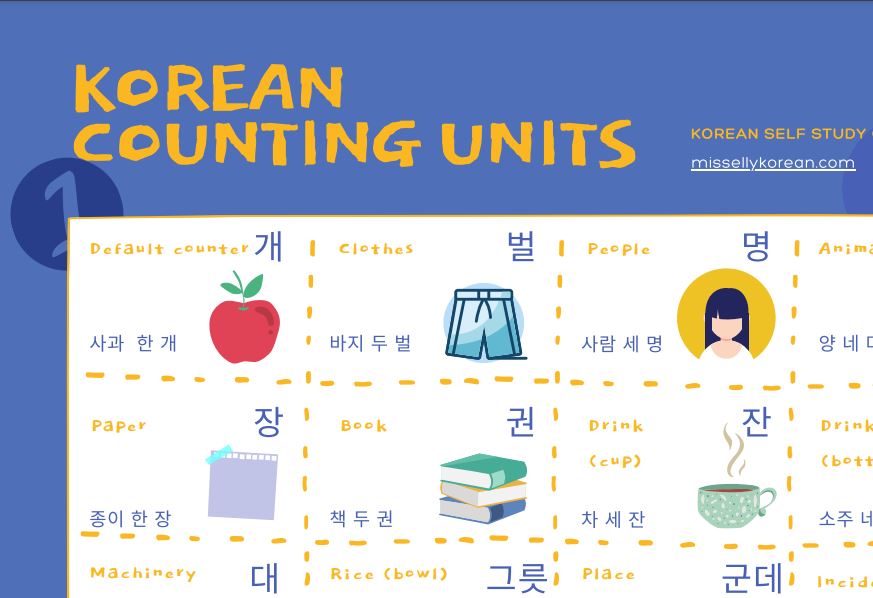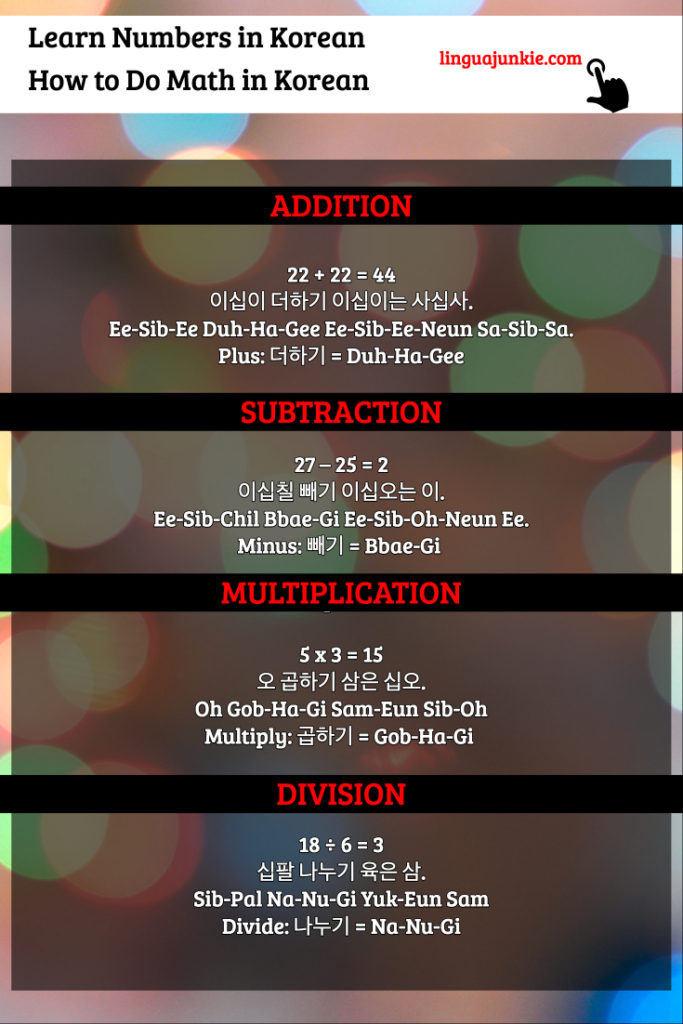
Korean Counting Units (with PDF summary) Miss Elly Korean
In the Korean counting system, the Sino Korean words (Chinese numbers) for 100,100,10,000 are 백(百), 천(千), 만(萬). However, the specific native Korean words for 100, 1000, and 10,000 existed in the old days in Korea.People don't use them in day-to-day life conversations anymore, and they have almost forgotten.

Counting in Korean Korean Pinterest Korean, Count and Language
When counting items in Korean, a specific 'counter' is used. This is similar to English expressions like 'Three heads of cattle' or 'Three sheets of paper'. [item] [number] [counter]고양이 세 마리 Three cats.. In English one can simply say 'Three cats', but in Korean one must say 'Three heads of cats' because the counter is compulsory.

Counting days in Korean Learn Basic Korean, How To Speak Korean, Korean
The word 명 (myeong) is another common Korean word used for counting people: 사람 한 명 (saram han myeong) One person. 사람 두 명 (saram du myeong) Two people. 사람 세 명 (saram se myeong) Three people. If you don't know the specific counting word to use, just do your best to pick the one that you think is the best match. You.

Table 14 Korean language, Korean alphabet, Korean
*There's no word to say "zero" in the Native Korean counting system. Instead, you can use 공 (gong) from Sino-Korean. Koreans also say 제로 (jero), from the English word "zero," for counting zero. 3. How to Say 10-100 in Sino and Native Korean. This time, let's count from 10 to 100.

Learn to Count in Korean Korean words, Korean language learning
한 (han) is the native Korean number for 1, it's the same meaning as 하나 (hana). 삼십오 (samsib-o) is the Sino-Korean number for 35. 시 (si) and 분 (bun) are the words used to measure hours and minutes, respectively. Thus, by combining all the numbers and their counterwords, it is easy to tell the time in the Korean language.

Learning Korean — Counting Numbers by Judy Jun Medium
Counters Used: 명 / 사람 / 분. Example: 세 명 / 세 사람 / 세 분 (three people) Yes, there are indeed multiple counters you can use for your fellow human beings. All of them literally translate to "person" or "people" but each one is used a little bit differently. 명 is a rather informal counter and one used among casual company.

Korean Counting Words with Image YouTube
Up to a game to practice count words in Korean? In this game, 8 counters are given, and you need to match them with the items provided. Hints on counters: Loads of them. Some of them are used with Sino-Korean numbers (eg. month, day, minute), others are used with Native Korean numbers. The counters in this game all go with Native Korean numbers.

Counting in Korean Belajar, Bahasa asing, Pemahaman membaca
Phone numbers. For example, when saying "010 - 5555 - 5555", all the zeros should be read as "공.". If you don't live in Korea, you probably won't know this, but "010" is the typical area code for a cell phone (in Seoul, at least). Therefore, when giving your phone number, you usually start out by saying "공-일-공".

(Korean Grammar🙂) Counting Words with Numbers/ Peoplewith Song📚 ️
List of item counters with native Korean numbers. Most of the item counters in Korean language are accompanied by the native Korean number system. The order is to use the object or item + number + Korean counting word. The examples below are written in Hangeul (Korean Alphabet) and romanized English.

Counting Numbers In Korean The Korean Numbering System Korean Images
From Wikipedia, the free encyclopedia. The Korean language uses special measure or counting words for specific objects and events. These suffixes are called subullyusa ( 수분류사; 數分類詞) in Korean. They are similar to the ones employed in the Chinese and the Japanese languages. In English it is "two sheets of paper", not "two papers".

Learning Korean Learn korean, Korean language, Korean lessons
7 Il-gop (일곱) 8 Yeo-deol (여덟) 9 A-hop (아홉) 10 Yeol (열) Once you've learned how to count to ten in Korean, you'll find it quite easy to keep counting to higher numbers. For numbers eleven through nineteen, you just combine ten and a number to count higher. So for example, the word for 11 is the same as 10 + 1.

Learn Korean Counting from 110 in Korean YouTube
The word "Yul" means 10 in Korean. So, if you want to say the number 11, you say Yul and the word for 1, Hah nah: Yul Hah nah. And so on for numbers 11 through 19. The word is pronounced "yull.". The number twenty is "Seu-Mool" - pronounced "Sew-mool.". For numbers 21 through 29, start with the Korean word for 20.

🇰🇷 WHY ARE THERE SO MANY KOREAN COUNTING WORDS!?! YouTube
The Korean language uses special measure or counting words for specific objects and events. These suffixes are called subullyusa (수분류사; 數分類詞) in Korean.They are similar to the ones employed in the Chinese and the Japanese languages.. In English it is "two sheets of paper", not "two papers". Analogously, in Korean jang (장/ 張) is used to count sheets or anything that is a.

Counting to Ten in Korean Learn Korean with Fun & Colorful Infographics
So, here's how you start counting in Korean, from 1 to 100 in 5 minutes. Part 1: 0 to 10 in Korean. Part 2: 11 to 20 in Korean. Part 3: 21 to 30. Part 4: Counting to 100 in Korean. Part 5: How to Do Math in Korean. Before we begin, you need to know that there are 2 ways of counting numbers in Korean. There's 1) the Sino-Korean system and 2.

Ultimate Guide for Counting in Korean Numbers 1100
We'll start with the Korean numbers 1 to 100, and then learn to count to over a billion by only learning a few Korean counting words. This lesson will also give you exercises to help you check your understanding of the Korean number system. Korean Counting. When counting in Korean, you will only need to learn around 35-40 numbers.

Let's ROK and Roll Learn Korean Basic Training
First, Koreans use native Korean numbers for counting a small number of items. To count a large number of objects you have to use Sino-Korean numbers instead. Secondly, some native Korean numbers (i.e. 1,2,3,4 & 20) have different forms when you use counters. 1 = 하나 -> 한. 2 = 둘 -> 두.